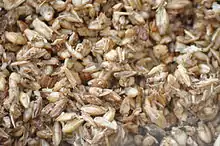Brewer's spent grain
Brewer's spent grain (BSG) or draff is a food waste that is a byproduct of the brewing industry that makes up 85 percent[1] of brewing waste. BSG is obtained as a mostly solid residue after wort production in the brewing process. The product is initially wet, with a short shelf-life, but can be dried and processed in various ways[2] to preserve it.

.jpg.webp)

Because spent grain is widely available wherever beer is consumed and is frequently available at a low cost, many potential uses for this waste have been suggested and studied as a means of reducing its environmental impact, such as use as a food additive, animal feed, fertilizer or paper.[3]
Composition
The majority of BSG is composed of barley malt grain husks in combination with parts of the pericarp and seed coat layers of the barley. Though the composition of BSG can vary,[4] depending on the type of barley used, the way it was grown, and other factors, BSG is usually rich in cellulose, hemicelluloses, lignin, and protein.[2] BSG is also naturally high in fiber, making it of great interest as a food additive, replacing low-fiber ingredients.
Food additive
The high protein and fiber content of BSG makes it an obvious target to add to human foods. BSG can be ground and then sifted into a powder that can increase fiber and protein content while decreasing caloric content, possibly replacing flour in baked goods and other foods, such as breadsticks,[5] cookies,[6] and even hot dogs.[7] Some breweries that also operate restaurants re-use their BSG in recipes, such as in pizza crust.[8] Grainstone is an Australian based company that has developed a world leading modular energy efficient process to convert BSG to a premium specialty flour and a process to produce nutraceuticals; including protein isolate, soluble dietary fibre and antioxident.[9]
Livestock feed

The low cost and high availability of BSG has led to its use as livestock feed. BSG can be fed to livestock immediate in its wet stage or once processed and dried. The high protein content in BSG offers a wide variety of amino acids essential in the diet of livestock.[1] In fact, supplementing BSG in cow diets may increase milk yield, milk total solids content, and milk fat yield, when compared to maize.[10]
Fertilizer
BSG may be an effective, affordable soil amendment for agricultural purposes. Its high protein content[11] translates to high nitrogen availability in soils, which could be ideal for many common crops such as beets, spinach, kale, and onions. In combination with compost, BSG may improve germination rate and the availability of organic matter in soil.[12] Studies have shown that BSG in addition to compost has a stronger, positive effect on germination than compost alone.[12] An additional study has shown that the inclusion of BSG in soil is more effective at sodic soil reclamation and corn seed germination than gypsum, which is traditionally used in sodic soils.[13]
Paper

BSG can be used to making recycled paper. It's called Craft Beer Paper or Beer Paper. Because of BSG, the paper shows subtle beer hue. It has made be postcards, coasters, gift boxes, and A4 and B5-sized beer paper sheets that can be printed just like regular white printing paper.
Beer Paper had obtained FSC® certification.[14]
Ceramics
Brewery's spent grains could be recycled through their incorporation in a traditional ceramic paste used in the manufacture of common bricks. This incorporation affects the mechanical strength, porosity, and thermal conductivity of the ceramic material.[15]
See also
References
- Mussatto, Solange I (May 2014). "Brewer's spent grain: a valuable feedstock for industrial applications: Brewer's spent grain and its potential applications". Journal of the Science of Food and Agriculture. 94 (7): 1264–1275. doi:10.1002/jsfa.6486. hdl:1822/31486. PMID 24254316.
- Aliyu, Salihu; Bala (November 20, 2010). "Brewer's spent grain: A review of its potentials and applications". African Journal of Biotechnology. 10: 324–331 – via Academic Journals.
- NEWS, KYODO. "FEATURE: Japan craft brewers drink to success of startup's new "beer paper"". Kyodo News+. Retrieved 2023-09-08.
- Santos, M; Jiménez, J.J; Bartolomé, B; Gómez-Cordovés, C; del Nozal, M.J (January 2003). "Variability of brewer's spent grain within a brewery". Food Chemistry. 80 (1): 17–21. doi:10.1016/s0308-8146(02)00229-7. ISSN 0308-8146.
- Ktenioudaki, Anastasia; Chaurin, Valérie; Reis, Sofia F.; Gallagher, Eimear (2012-06-11). "Brewer's spent grain as a functional ingredient for breadsticks". International Journal of Food Science & Technology. 47 (8): 1765–1771. doi:10.1111/j.1365-2621.2012.03032.x. ISSN 0950-5423. S2CID 55196395.
- Öztürk, S.; Özboy, Ö.; Cavidoğlu, İ; Köksel, H. (2002). "Effects of Brewer's Spent Grain on the Quality and Dietary Fibre Content of Cookies". Journal of the Institute of Brewing. 108 (1): 23–27. doi:10.1002/j.2050-0416.2002.tb00116.x. ISSN 0046-9750.
- Özvural, Emin Burçin; Vural, Halil; Gökbulut, İncilay; Özboy-Özbaş, Özen (June 2009). "Utilization of brewer's spent grain in the production of Frankfurters". International Journal of Food Science & Technology. 44 (6): 1093–1099. doi:10.1111/j.1365-2621.2009.01921.x. ISSN 0950-5423.
- Montgomery, Tyler (13 July 2015). "Jackie O's Brewery Goes Field to Table … Field to Brew". Brewer. Retrieved 3 January 2020.
- "Home". grainstone.com.au.
- Belibasakis, N.G.; Tsirgogianni, D. (February 1996). "Effects of wet brewers grains on milk yield, milk composition and blood components of dairy cows in hot weather". Animal Feed Science and Technology. 57 (3): 175–181. doi:10.1016/0377-8401(95)00860-8. ISSN 0377-8401.
- Waters, Deborah M.; Jacob, Fritz; Titze, Jean; Arendt, Elke K.; Zannini, Emanuele (2012-08-15). "Fibre, protein and mineral fortification of wheat bread through milled and fermented brewer's spent grain enrichment". European Food Research and Technology. 235 (5): 767–778. doi:10.1007/s00217-012-1805-9. ISSN 1438-2377. S2CID 85738682.
- Aboukila, Emad F.; Nassar, Ibrahim N.; Rashad, Mohamed; Hafez, Mohamed; Norton, Jay B. (October 2018). "Reclamation of calcareous soil and improvement of squash growth using brewers' spent grain and compost". Journal of the Saudi Society of Agricultural Sciences. 17 (4): 390–397. doi:10.1016/j.jssas.2016.09.005. ISSN 1658-077X.
- Aboukila, Emad (2019-06-30). "Use of Spent Grains, Cheese Whey, Gypsum, And Compost for Reclamation of Sodic Soils and Improvement of Corn Seed Germination". Alexandria Science Exchange Journal. 40 (APRIL–JUNE): 314–328. doi:10.21608/asejaiqjsae.2019.34188. ISSN 2536-9784.
- "モルト粕活用クラフト紙「クラフトビールペーパー」、FSC®認証を取得。回収したモルト粕は1000kgを突破". プレスリリース・ニュースリリース配信シェアNo.1|PR TIMES. 2022-12-15. Retrieved 2023-09-08.
- Ferraz, E.; Coroado, J.; Gamelas, J.; Silva, J.; Rocha, F.; Velosa, A. (2013). "Spent Brewery Grains for Improvement of Thermal Insulation of Ceramic Bricks". Journal of Materials in Civil Engineering. 25 (11): 1638–1646. doi:10.1061/(ASCE)MT.1943-5533.0000729.